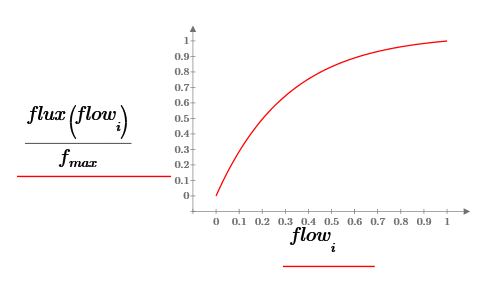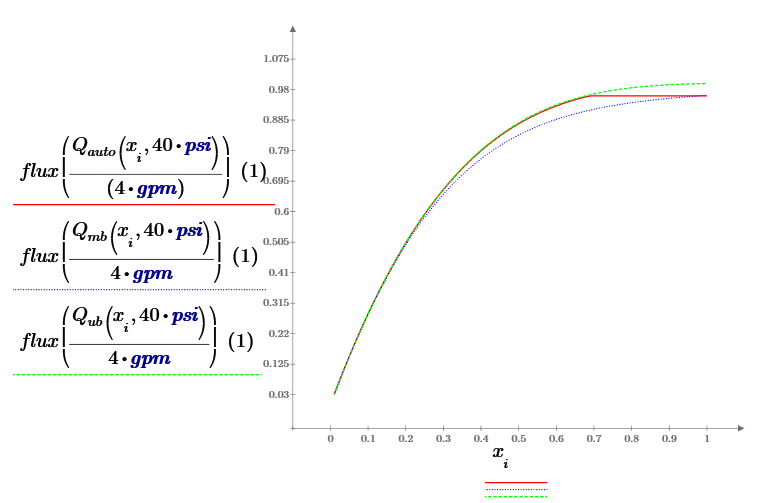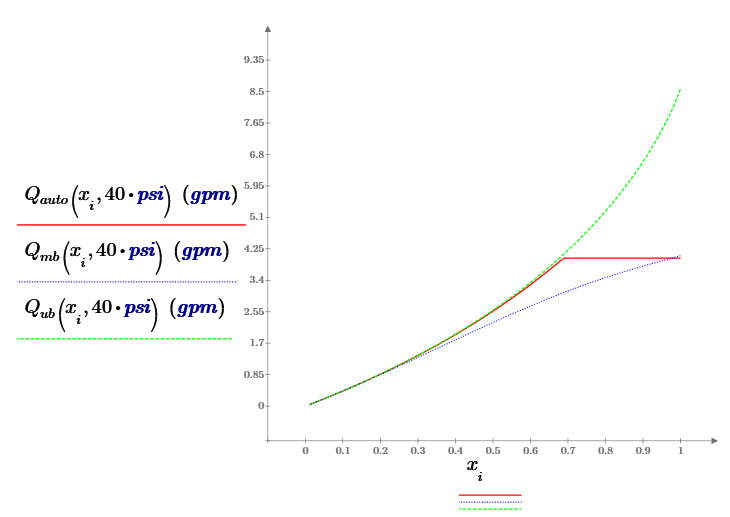Modulating Control Valves and Autoflow™
The question comes up regularly: does Autoflow™ interfere with the operation of a modulating control valve? After all, as the control valve closes, the Autoflow will be opening.
In short, of course it will make a difference, but it will not be worse than without the Autoflow™.
Saturation
The rate of heat flux from the water in a coil to the air depends on the temperature difference between the two at the point of contact. Thinking about this, it’s clear that the theoretical upper limit of output for a coil would happen when the inlet water temperature was the temperature at the inner surface of the tube over the whole surface. Thus, as flow increases, the heat transfer “saturates” as the temperature of the water leaving the coil gets closer to the temperature entering.

It is not uncommon to design a terminal so that the output under design conditions is 95% saturated with respect to water flow. Under these conditions, doubling the water flow would only make a 4% change in output.
Square Law
Water flow is typically turbulent: It’s just a consequence of high density and low viscosity. The result is that when the flow of water through a fixed restriction is reduced to 50%, the pressure drop becomes about 25%.
This is significant, because as the control valve restricts the flow, all other pressure drops in the local circuit become trivial and the control valve takes all the pressure drop. If a balancing restriction of 32 psi is made by a manual valve, at 50% flow it will be making an 8 psi pressure drop. For Autoflow, the pressure drop will admittedly be down to about 0.25 psi. The thing is, though, that the control valve is now seeing an extra 24 psi in one case and an extra 32 psi in the other. Assuming it was sized for 5 psi, this means comparing 29 psi to 37 psi. The square law works the other way when comparing flow at different pressures: the Autoflow system would flow about 63% of maximum if the manual valve is at 50% of maximum.
Net Effect
With a properly characterized control valve, the heat transfer as a function of stem position is almost exactly the same whether manual balancing, automatic balancing, or no balancing is used:

This might prompt the question why to balance. The answer lies in comparison of the water flow under the same conditions:

So, while the thermal result as a function of stem position is almost the same, the unbalanced system will waste water flow ridiculously when the demand is near to the design conditions. So if the water flow is so much higher, why is the heat transfer not? Simple. The “delta T” of the water is very low for the unbalanced system.
Summary
Even in the case when Autoflow™ must absorb 32 psi to prevent overflow, it does not significantly affect the performance of the control valve. This is because regardless of how the system is balanced, the control valve will see very nearly the full pressure drop across the circuit by the time it throttles to half flow, which is typically 80% of heat transfer, and overflow contributes very little added heat transfer.
Thus, a commonly cited argument against automatic balancing is a misconception. The advantages, however, are not. An automatically balanced system prevents wasted circulation under all conditions while allowing variable speed pumps to ramp back without starving the system. Automatic balancing also allows the system to work correctly from the moment it starts up, without a complex adjustment procedure. Finally, the use of fixed flow limiting cartridges such as Autoflow™ prevents uninformed personnel from unbalancing the system.

